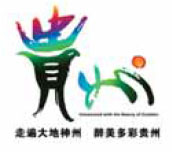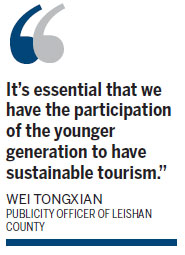

China's 'park province' seen as national jewel of ecological and cultural tourism
If Guizhou province were a wheel, Guiyang, the capital, would be the hub. Outward, beyond the city limits, lies a different world - 176,000 square kilometers of remote wilderness that has managed to remain, in many ways, untrammeled by modernity. Guizhou is sometimes referred to as China's park province.
For thousands of years, this region was blessed - or cursed - by the difficulty of travel. Until recent decades, the sheer raw ruggedness of Guizhou's terrain kept development at bay. Roads through its wild mountains are difficult to build and at least triple the cost per kilometer of roads in open country.
One effect of the challenging geography is that the many ethnic mountain peoples, with cultures rooted in antiquity - the Miao, the Buyi and the Dong, among many others - endured for a long time in pure form. Exchanges with the outside were limited.
But isolation has its drawbacks. Guizhou is today among the poorest province in China, and has been for many years, with per capita GDP standing at only 23,000 yuan ($3,700), a scant one-fourth of the country's largest developed provinces. Today's challenge for the ethnic peoples - which represent 37 percent of the province's total population - is not only to survive, but also to achieve a decent standard of living.
Pressed by China's booming economy, the groups have found they can't hold out. They must adapt, if only to put food on the table, as a younger generation breaks with tradition and moves to the cities in search of good paying jobs. Without replenishment by its young, no culture can survive.
That's a worry that has moved many people to action to preserve knowledge of the old ways - from the hill people's ancient songs and dances that carry their history forward, to their renowned embroidered costumes and silver crafts.
Saving the culture
In Shibing county of the Qiandongnan Miao and Dong autonomous prefecture, Pan Jiaxiang, 75, established the Shibing Miao Ethnic Group Research Center - part museum, part living history exhibit - to save what he can before it's too late.
"There are no Miao buildings anymore," said Pan, who once served as the county's head. "They don't wear Miao costumes. With urbanization, people are moving to the city. They don't speak the Miao dialect. The younger people leave the village to find a job, and they don't have a chance to hold on to the culture.
"This is the trend. The ethnic groups are disappearing. Soon, no one will know about the Miao. I feel a sense of crisis."
Pan is not alone in his sentiment. Others, both individuals and the regional and national governments, feel the same sense of urgency and are taking action in their own ways. Much has been accomplished. Beijing is now paying special attention to Guizhou and extending favorable policies. Above all, it's providing assistance in the way of transportation infrastructure to help the region profit from its unique gifts of natural and cultural heritage and to improve local people's lives.

Today's vision is for Guizhou to become a national jewel of ecological and cultural tourism, with easy physical access - meaning the construction of highways and rail. Only about 70 of Guizhou's 90 counties are currently connected with modern roads. By the end of 2015, all will be connected as part of a broad transportation strategy to support tourism as a major industry.
By the end of 2014, two high-speed rail lines, now under construction, will connect the capital, Guiyang, to the country's major markets. One line linking with Guangzhou, 1,500 kilometers away in South China, will shorten the overland trip to the sea to just five-hours. Another line to Chongqing will give easy access to the Guizhou from points north, including Beijing.
All this bodes well as an economic lifeline for the province. Tourism is expected to provide a major influx of cash in the long run. But what will visitors see? Roads don't solve the problem of cultural preservation. The solution to that must be created locally, village by village.
In Langde Miao village in the lush outskirts of Kaili city, visitors are met by a wave of color and sound from the hillside. High up, men blow into tall pipes to produce a low, bellowing greeting. A gauntlet of Miao women, attired in traditional costumes with elaborate embroidery and silver adornments, form a line up the slope and dish out clear liquor at a dozen tables - it's the forerunner of Moutai, China's national liquor. Visitors are given a sip from a bull's horn at each station to gain entrance to the village enclave above. (Warning: Don't touch the horn; if you do, you are required by local rules to consume its full contents.)
Inside the gate is a wide, stone courtyard, where the voices of young women are lifted in traditional songs, and ancient dances are performed to the pounding beat of drums.
What's most significant is the age of the performers.
Engaging the young
"It's essential that we have the participation of the younger generation to have sustainable tourism, and we have several programs to encourage them, including singing competitions," said Wei Tongxian, publicity officer of Leishan county.
Starting in primary school, children begin to learn the old ways. At various stages, the most enthusiastic and committed students become eligible for rewards.
"We give several young people each year the title 'Inheritor of the Culture'," Wei said. "The winners at different levels receive financial compensation."
The pride of the performers is evident at Langde village as the song-and-dance show moves joyfully to a crescendo, entertaining a crowd of outsiders seated in the open-air amphitheater.
But Wei adds a word of caution about commercialism. It's not just the money that's important; balance and harmony are needed just as much, he said. While visitors are required to sustain a healthy local economy, too many would erode authenticity. Currently the village receives about 100,000 visitors annually, and Wei said visitation should be capped at around 150,000.
"As a cultural heritage, we want to try our best to keep the village and the culture as original as it can be," he said. "If commercialism encroaches too much, it will destroy this."
"It's a dilemma," he said. "Too little commerce means no financial base, but too much would take us beyond our capabilities. With an overabundance of tourism, the villagers would compete to provide more accommodations - hotels and restaurants - and use more modern architecture instead of preserving the old styles. This would destroy the original feel, which is a treasure in this county."
Wei noted several spots in China that are "overdeveloped" or "so commercialized that they have destroyed the original thing, so that it's no longer sustainable or attractive".
"So we want to approach the development of tourism in a sustainable way," he said. "Of course, we want tourists to come here, but we want to attract them with original culture."
New approach
Not far up the road, in Maba village of the Buyi ethnic group in Guiding county, 37-year-old Lan Heng is both teacher and participant. He has styled himself as the "chief" of the clan and leads a mixed group of performers young and old. He himself plays an instrument called a lusheng, a multi-pipe contraption two meters long that vaguely recalls a bagpipe, but without the bag.
Lan, wearing a headdress with vertical feathers, demonstrates his chief's dance as he plays the lusheng, dipping, swerving and spinning to the rhythm. Meanwhile, the omnipresent drums seem to echo back through time.
"The Buyi music and dance performance is facing extinction," he said. "In order to preserve it, and with the support of the government, I became a teacher."
To pass on ethnic culture, you have to start young, he said. And his middle school students have quickly become "good enough by high school to perform by themselves individually without direction, though not yet capable of teaching both the music and the movements".
Ironically, his efforts were opposed at first by village elders uncomfortable with the mass production of culture through a school setting rather than growing it organically in the community. But Lan won them over, and they now see the wisdom of this approach in light of modern economic realities. "They now understand that this is the trend, the way to success," he said.
Around 10,000 students have taken Lan's class, about 200 of which have become highly skilled, he said. That's an enviable record for any preservationist, but for Lan, it's personal:
"This performance has been passed on through hundreds or thousands of years," Lan said. "My father and my grandfather also knew how to play it, and now I feel it's my duty to pass it to the next generation."
Ethnic songs and dances are not the only things that need preserving. Across the Taiwan Straits, in Taipei, architect Huang Ying-feng has devoted the last 20 years of his life to collecting and recording the embroidery techniques used to create the stunning handcrafted clothing of some 26 ethnic groups in southwest China. Thirteen of those groups are in Guizhou province, which Huang calls his "second home". He has visited more than 400 villages, and continues monthly, to record their textile techniques, as well as the historical cipher contained in the needle-and-thread pictures and fine silver adornments.
Lacking a written language, the hill people provide glimpses of their past through their extraordinary art, Huang said. While the Han group was writing on paper, the hill people were writing with thread. Each clan developed its own particular style that can be distinguished from others.
Huang's collection of Chinese ethnic embroidery has grown to become the finest in the world. There are more than 16,000 pieces in the collection of the Evergrand Art Museum in Taipei, which he founded and directs as a labor of love. The collection is valued at $200 million. Five hundred pieces toured the United States in 2008, with stops in Wisconsin, New Mexico and Hawaii.
"Commercialism and tourism have led to the disappearance of traditional minority villages and the meanings embedded in their crafts," Huang said. "Ready-made clothes are replacing the formerly elaborate work at a rapid pace. So economic development is a double-edged sword. I have strived to build awareness of the rich cultural traditions because I can see the tragedy of their loss."
"Thousands of years of knowledge and skill are disappearing," he said. "I'm in a hurry about it."
The writer is a senior editor at China Daily
|
With rapid modernization, facilities such as supermarkets have become a necessary part of life for Guizhou's ethnic people. |
|
Miao ethnic women hawk inexpensive embroidery to visitors. Genuine handmade embroidery can still be found as well. Photos by Zhu Xingxin / China Daily |
|
A girl at Langde Miao village near Kaili city offers a bowl of liquor to welcome guests. |